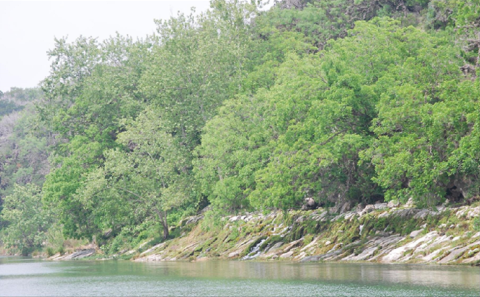The U.S. Fish and Wildlife Service (Service) is listing the South Llano springs moss (Donrichardsia macroneuron) as endangered under the Endangered Species Act (ESA). The last known site of the species’ occurrence is at a privately owned spring with constant flows of mineral-rich water along the South Llano River.
“The South Llano springs moss occurs only in one small population at a remote spring site on the South Llano River, making it vulnerable to catastrophic events like drought and floods,” said Karen Myers, Field Supervisor at the Service’s Austin Ecological Services Field Office. “By protecting this species under the ESA, we can help preserve the unique biodiversity of this ecosystem and generate conservation partnerships that benefit all of the plants and wildlife that depend on this water resource.”
Primary threats to the moss include groundwater pumping from the Edwards-Trinity Aquifer and reduced and interrupted spring flow resulting from an increase in the severity and duration of droughts and rain events. Additionally, the encroachment of non-native plants, herbicide use, and reduced water quality potentially threaten the species.
In the proposal to list the South Llano springs moss as endangered in September 2021, the Service also proposed 0.48 acres of critical habitat at Seven Hundred Springs, the only location where the moss is found. Based on input submitted during the public comment period, the Service has excluded this single unit from the final rule after determining that the benefits of excluding it outweigh the benefits of including it.
“Since the South Llano springs moss occurs only in one privately owned spring, the conservation and recovery of this species is entirely dependent upon cooperation and coordination with the landowner,” Myers said. “Excluding the unit of proposed critical habitat will provide benefits to the species and its habitat by strengthening our positive relationship with the landowner, who has worked with the Service’s Partners for Fish and Wildlife Program multiple times to improve plant and wildlife habitat on their land.”
The Service will continue to collaborate with local landowners and private lands organizations to improve rangeland and vegetation management within the Edwards-Trinity Aquifer recharge zone, and within the upper South Llano River watershed. Efforts to manage and conserve the Edwards-Trinity Aquifer itself contribute to the uninterrupted flow of spring water and protection of this species’ habitat.
The rule to list the South Llano springs moss as endangered under the ESA will publish in the Federal Register on April 27, 2023.
America’s fish, wildlife and plant resources belong to all of us, and ensuring the health of imperiled species is a shared responsibility. The Service is actively engaged with conservation partners and the public in the search for improved and innovative ways to conserve and recover imperiled species. To learn more about the Endangered Species program, go to http://www.fws.gov/endangered/.




